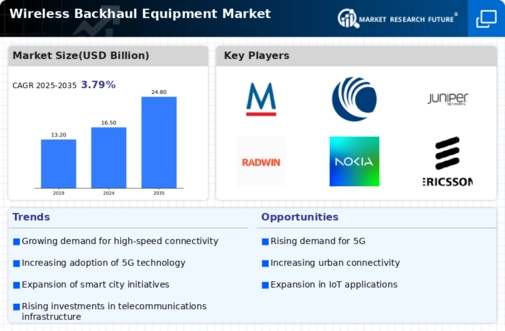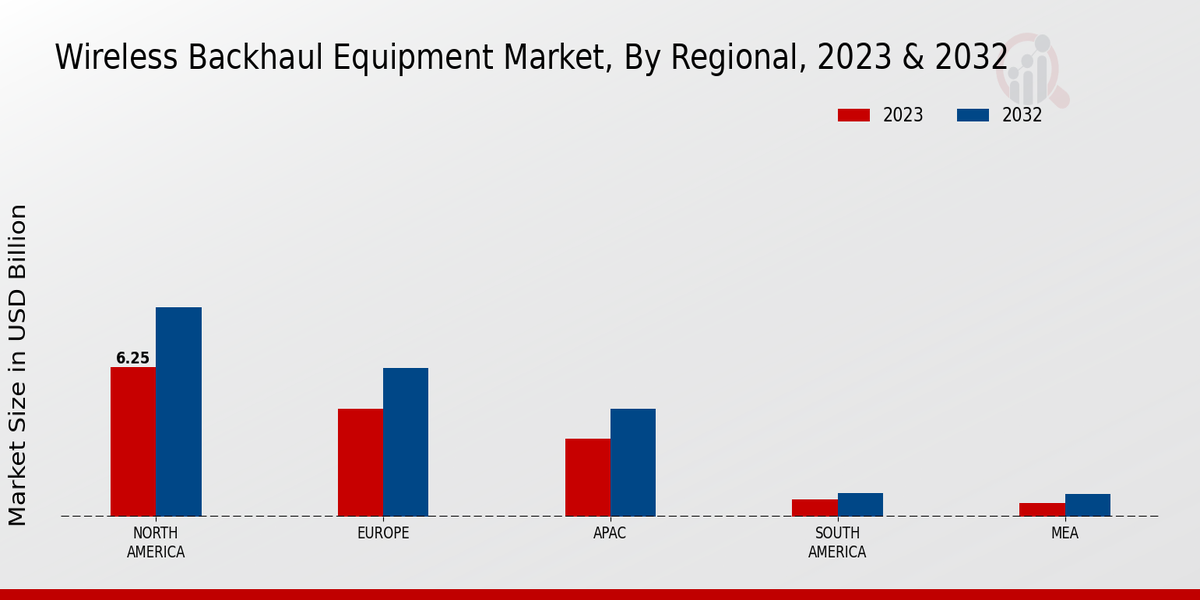Expansion of 5G Networks
The rollout of 5G networks globally serves as a significant catalyst for the Global Wireless Backhaul Equipment Market Industry. With the promise of ultra-fast data rates and low latency, 5G technology necessitates advanced backhaul solutions to support its infrastructure. As countries invest heavily in 5G deployment, the demand for wireless backhaul equipment is expected to surge. This transition is not merely a technological upgrade; it represents a paradigm shift in telecommunications. By 2035, the market is anticipated to grow to 24.8 USD Billion, driven by the need for efficient data handling and the capacity to support a multitude of connected devices.
Market Growth Projections
The Global Wireless Backhaul Equipment Market Industry is poised for substantial growth, with projections indicating a market size of 16.5 USD Billion in 2024 and an anticipated increase to 24.8 USD Billion by 2035. This growth trajectory suggests a robust demand for wireless backhaul solutions, driven by factors such as the expansion of 5G networks, increased investment in smart cities, and the rising adoption of cloud services. The compound annual growth rate (CAGR) of 3.79% from 2025 to 2035 further underscores the market's potential. Such projections highlight the critical role that wireless backhaul equipment will play in supporting the evolving telecommunications landscape.
Rising Adoption of Cloud Services
The growing adoption of cloud services across various sectors is significantly impacting the Global Wireless Backhaul Equipment Market Industry. As businesses migrate their operations to the cloud, the need for efficient data transfer and storage solutions becomes paramount. Wireless backhaul equipment facilitates this transition by ensuring that data can be transmitted quickly and reliably between cloud servers and end-users. This trend is expected to contribute to a compound annual growth rate (CAGR) of 3.79% from 2025 to 2035. The shift towards cloud-based solutions not only enhances operational efficiency but also drives the demand for advanced backhaul technologies.
Emergence of Advanced Technologies
The emergence of advanced technologies, such as Artificial Intelligence (AI) and Machine Learning (ML), is reshaping the Global Wireless Backhaul Equipment Market Industry. These technologies enable more efficient network management and optimization, allowing operators to enhance their service offerings. By integrating AI and ML into backhaul solutions, companies can improve their ability to predict network demands and dynamically allocate resources. This innovation is crucial as networks become increasingly complex with the rise of IoT and 5G. The integration of these technologies not only improves operational efficiency but also positions companies to better meet the evolving needs of consumers and businesses.
Increased Investment in Smart Cities
The global trend towards the development of smart cities is another influential driver for the Global Wireless Backhaul Equipment Market Industry. Governments and municipalities are increasingly investing in smart infrastructure to enhance urban living through improved connectivity, traffic management, and public safety. Wireless backhaul equipment plays a crucial role in enabling the communication between various smart devices and systems. As cities evolve into interconnected ecosystems, the demand for reliable backhaul solutions is likely to rise. This investment not only supports economic growth but also enhances the quality of life for residents, thereby creating a favorable environment for market expansion.
Growing Demand for High-Speed Connectivity
The increasing demand for high-speed internet connectivity is a primary driver of the Global Wireless Backhaul Equipment Market Industry. As more consumers and businesses rely on seamless connectivity for various applications, including streaming, gaming, and remote work, the need for robust backhaul solutions intensifies. In 2024, the market is projected to reach 16.5 USD Billion, reflecting the urgency for enhanced infrastructure. This demand is further fueled by the proliferation of smart devices and the Internet of Things (IoT), which require reliable data transmission capabilities. Consequently, wireless backhaul equipment becomes essential for network operators to meet these escalating connectivity expectations.
















